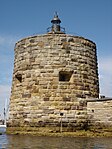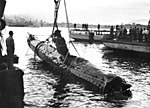Robertson Point Light
1910 establishments in AustraliaAustralian building and structure stubsLighthouse stubsLighthouses completed in 1910Lighthouses in Sydney ... and 2 more
New South Wales building and structure stubsUse Australian English from April 2018

Robertson Point Light, also known as Cremorne Point Light, is an active lighthouse in Cremorne Point, a suburb on the lower North Shore of Sydney, New South Wales, Australia. It is the sibling of Bradleys Head Light. The lighthouse is mounted on a rock and connected to shore by a footbridge. The light characteristic shown is a green occulting light with a cycle of three seconds (Oc.G. 3s), the same as Bradleys Head Light.
Excerpt from the Wikipedia article Robertson Point Light (License: CC BY-SA 3.0, Authors, Images).Robertson Point Light
Milson Road, Sydney Cremorne Point
Geographical coordinates (GPS) Address External links Nearby Places Show on map
Geographical coordinates (GPS)
| Latitude | Longitude |
|---|---|
| N -33.848783333333 ° | E 151.23301388889 ° |
Address
Robertsons Point
Milson Road
2090 Sydney, Cremorne Point
New South Wales, Australia
Open on Google Maps










